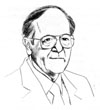Ron Howing
 Ron Howing, an award winner in the Outstanding Wetlands Program Development category, has been a wildlife biologist for the Iowa Department of Natural Resources (DNR) in northwest Iowa since 1963. Throughout his career Howing has been involved with many successful programs, but his innovative work in the field of wetland restoration constitutes his greatest contribution. Howing works in the heart of the prairie pothole region of Iowa, an area that once contained over two million acres of wetlands. These pothole wetlands, left by the retreating glaciers, were drained for agriculture when early settlers learned that the soils were highly fertile. Since the late 1800s, nearly 98 percent of Iowa’s wetlands have been drained.
Ron Howing, an award winner in the Outstanding Wetlands Program Development category, has been a wildlife biologist for the Iowa Department of Natural Resources (DNR) in northwest Iowa since 1963. Throughout his career Howing has been involved with many successful programs, but his innovative work in the field of wetland restoration constitutes his greatest contribution. Howing works in the heart of the prairie pothole region of Iowa, an area that once contained over two million acres of wetlands. These pothole wetlands, left by the retreating glaciers, were drained for agriculture when early settlers learned that the soils were highly fertile. Since the late 1800s, nearly 98 percent of Iowa’s wetlands have been drained.
In 1987, the trend of wetland losses finally began a slow reversal with the implementation of the Conservation Reserve Program (CRP) by the U.S. Department of Agriculture (USDA). Howing was among the first to realize the wetland restoration potential of the CRP program in Iowa. CRP paid landowners to remove highly erodible land from production for ten years. Provisions within the CRP regulations also allowed landowners to remove certain wetlands from production for the same period. Howing contacted numerous local landowners, convinced them of the benefits of wetlands restoration, and restored the first basins using Iowa DNR equipment and funds from his operating budget.
Also in 1987, the U.S. Fish and Wildlife Service (FWS) began its Partners for Wildlife program, which provides limited cost sharing and technical assistance to landowners interested in restoring their wetlands. Howing’s success with wetland restorations helped set the stage for a partnership between the FWS and the USDA. Since the original restoration in 1987, this cooperative venture has restored 622 wetlands covering 2,691 acres in Iowa. Howing’s foresight, initiative, and dedication not only proved that high quality wetlands can be restored in Iowa but helped spark a program that continues to gain public support.
Those early private land restorations were only the beginning of Howing’s contributions to wetland restoration and conservation. The implementation of the North American Wa terfowl Management Plan in 1988 again brought Iowa DNR and the FWS together to address wetlands loss in the state. Under that partnership, Howing has worked with the FWS Small Wetland Acquisition Program to purchase outright and to acquire perpetual easements on wetlands areas. In Palo Alto and Emmet counties, he has negotiated the purchase and restoration of 1,589 acres as waterfowl production areas.
In 1991, the FWS introduced the Wetlands Easement Program in Iowa. This program has been used in Minnesota and the Dakotas since the 1960s as a means of protecting wetlands from drainage. Because nearly all of Iowa’s wetlands were already drained, the program had to include restoration as well as protection.
Once again, Howing took the initiative to find landowners to participate in the program. Again, his unending belief in wetland values and his knack for sharing that information with landowners has resulted in 14 landowners placing 289 acres under permanent easements. In the summer of 1993, Howing negotiated the single largest easement complex in Iowa: a mix of wetland types totaling 82 acres, owned by three landowners. The combination of negotiation and technical skills needed to accomplish such a large, mixed ownership restoration is a rare talent.
Those who know Ron Howing often remark on his single-mindedness and ability to focus on an issue. It is indeed a strong part of his charac ter, and his friends and co-workers frequently smile at the difficulty encountered when trying to talk about something other than wetlands! Yet in the years to come, it is clear that the lasting smiles brought about by Ron Howing will be those on the faces of Iowans who are happy to see wetlands returned to their state.
— Barry Christenson, U.S. Fish and Wildlife Service